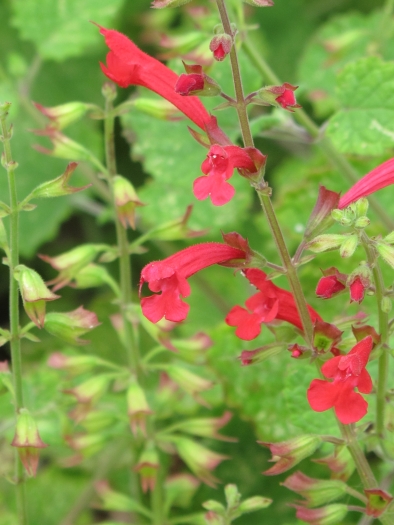Cedar Sage
(Salvia roemeriana)
Cedar Sage (Salvia roemeriana)
/
/

Scott Zona
CC BY 2.0
Image By:
Scott Zona
Recorded By:
Copyright:
CC BY 2.0
Copyright Notice:
Photo by: Scott Zona | License Type: CC BY 2.0 | License URL: https://creativecommons.org/licenses/by/2.0 | Uploader: Flickr upload bot | Publisher: Wikimedia Commons | Title: Salvia_roemeriana.jpg | Notes: User created page with UploadWizard |




















































Estimated Native Range
Summary
Salvia roemeriana, commonly known as Cedar Sage, is a deciduous perennial herb that is native to the understory of juniper-oak woodlands, often found on south-facing slopes, bluffs, and limestone outcrops in Central Texas and Northeastern Mexico. It typically grows up to 1 foot in height and width, forming dense clumps that can spread into colonies through prolific reseeding. Cedar Sage has grassy green foliage that dies back to the ground in winter. From spring to early summer, it produces abundant, bright scarlet flowers that are highly attractive to hummingbirds. The flowers grow in loose whorls above the foliage on 8–10 inch stalks, with each plant boasting multiple inflorescences, making it quite showy during its blooming period.
Cedar Sage is valued for its neat, compact growth habit, making it an excellent choice for edging and front-of-border placements in gardens. It is also used in native plant gardens and xeriscaping due to its low water requirements and adaptability to local conditions. Cedar Sage thrives in part shade to full sun and prefers well-drained soils, particularly those that are rocky or sandy. While it is drought-tolerant once established, it benefits from occasional watering during prolonged dry spells. This plant is relatively low-maintenance, but it can be susceptible to root rot if overwatered or planted in poorly drained soils.CC BY-SA 4.0
Cedar Sage is valued for its neat, compact growth habit, making it an excellent choice for edging and front-of-border placements in gardens. It is also used in native plant gardens and xeriscaping due to its low water requirements and adaptability to local conditions. Cedar Sage thrives in part shade to full sun and prefers well-drained soils, particularly those that are rocky or sandy. While it is drought-tolerant once established, it benefits from occasional watering during prolonged dry spells. This plant is relatively low-maintenance, but it can be susceptible to root rot if overwatered or planted in poorly drained soils.CC BY-SA 4.0
Plant Description
- Plant Type: Herb
- Height: 1-2 feet
- Width: 0.5-1 feet
- Growth Rate: Moderate
- Flower Color: Red
- Flowering Season: Spring
- Leaf Retention: Deciduous
Growth Requirements
- Sun: Part Shade, Full Sun
- Water: Low
- Drainage: Medium
Common Uses
Bee Garden, Bird Garden, Butterfly Garden, Deer Resistant, Drought Tolerant, Fragrant, Groundcover, Hummingbird Garden, Low Maintenance, Potted Plant, Rabbit Resistant, Salt Tolerant, Showy Flowers, Street Planting
Natural Habitat
Understory of juniper-oak woodlands, often found on south-facing slopes, bluffs, and limestone outcrops in Central Texas and Northeastern Mexico
Other Names
Common Names: Dwarf Crimson-Flowered Sage, Roemer’s Sage, Dwarf Crimson Sage, Karminsalvia
Scientific Names: , Salvia roemeriana, Salvia porphyrantha, Salvia porphyrata, Salvia engelmannii publ, Salvia roemerana,
GBIF Accepted Name: Salvia roemeriana Scheele